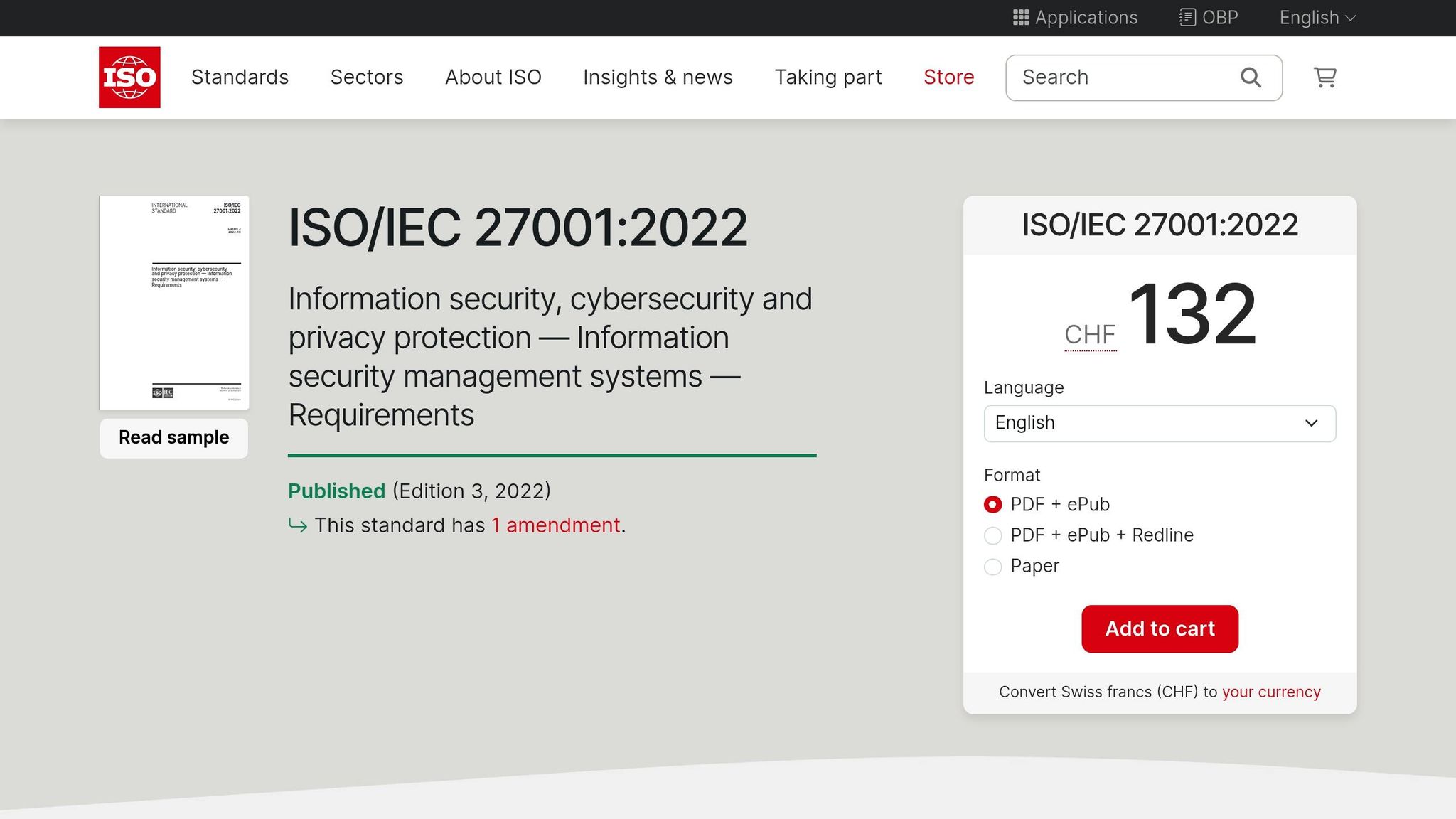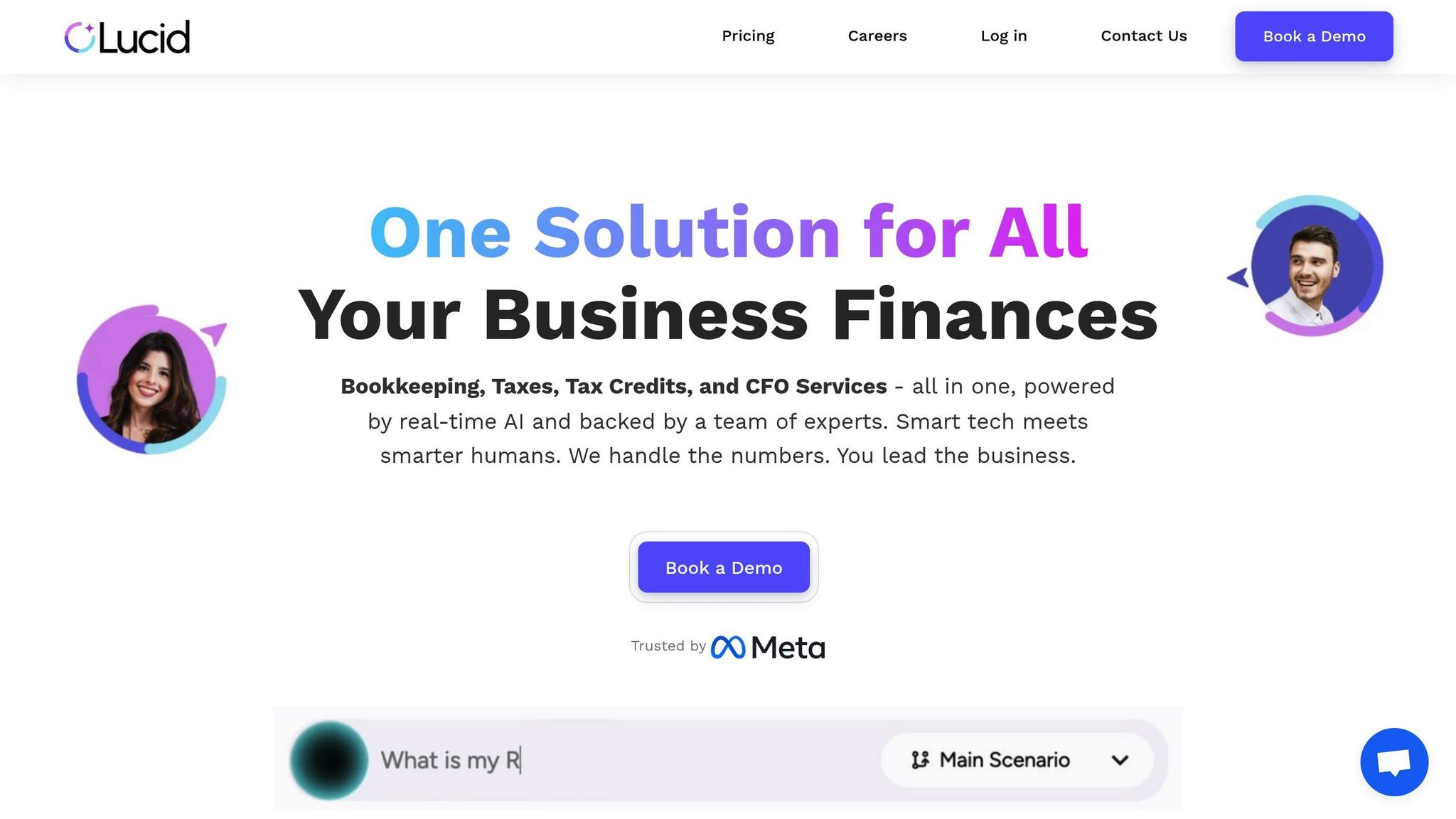Managing who can access your financial data is crucial for security, compliance, and investor trust. Regular data access reviews help ensure only the right individuals have access to sensitive information, reducing risks like data breaches and outdated permissions. For startups in the U.S., adhering to regulations like SOX, ISO 27001, and AML is not just a best practice - it’s often mandatory. These reviews also strengthen your position during audits and funding rounds by showcasing strong internal controls.
Key Takeaways:
- Why it matters: Protects sensitive data, prevents breaches, and builds investor trust.
- Challenges: Limited resources, manual processes, and navigating complex compliance requirements.
- Solutions: Focus on the principle of least privilege, document changes, and automate reviews with AI tools like Lucid Financials.
Bottom line: Regular reviews make compliance easier, reduce risks, and prepare your business for growth. Automation tools can save time and ensure your processes meet regulatory standards.
Coffee and Compliance: Demystifying Access Reviews
U.S. Compliance Requirements for Data Access Reviews
Getting a handle on which regulations apply to your startup is a crucial first step in creating a solid data access review process. The regulatory environment for financial data might feel complex, but focusing on a few key frameworks can simplify things. Your specific compliance requirements will depend on factors like your industry, company size, funding stage, and the type of financial transactions you manage. As your business evolves, tailoring your approach to meet these requirements is essential. These frameworks provide the foundation for the access review strategies discussed in the following sections.
Key Frameworks: SOX, ISO 27001, and AML

Sarbanes-Oxley Act (SOX) is primarily aimed at public companies, but many private companies preparing for an IPO adopt similar practices. This law mandates accurate financial recordkeeping and the implementation of internal controls over financial reporting. For data access, this means documenting who has the ability to view, modify, or approve financial data, ensuring permissions align with specific job roles. As your startup progresses through funding rounds, demonstrating strong internal controls can signal operational maturity to investors.
ISO 27001 offers a broader framework for managing information security. While not limited to financial data, it provides a structure to protect sensitive information across your organization. Regular access reviews are a key component of ISO 27001 certification, giving enterprise clients and global partners confidence in your security practices.
Anti-Money Laundering (AML) regulations target businesses in financial services, including fintech startups, cryptocurrency platforms, and payment processors. These rules require strict monitoring and reporting of suspicious financial activities. To comply, companies must enforce tight controls on transaction and customer data access. AML compliance often involves continuous oversight, tracking access patterns, investigating unusual activity, and maintaining detailed logs. Violations can result in severe penalties, making rigorous monitoring a priority.
Framework Requirements Comparison
| Framework | Scope | Review Frequency | Documentation Requirements | Enforcement |
|---|---|---|---|---|
| SOX | Public companies; often adopted by private firms preparing for IPO | Regular reviews and periodic management assessments | Internal control documentation, management certifications, audit trails | Overseen by the SEC; penalties include potential criminal charges |
| ISO 27001 | Organizations handling sensitive data | Annual management reviews and ongoing monitoring | Risk assessments, security policies, incident response plans | Certification audits and customer contract obligations |
| AML | Financial institutions, money services, cryptocurrency platforms | Continuous monitoring with periodic independent testing | Customer due diligence records, suspicious activity reports, training logs | Regulated by FinCEN and banking authorities; violations result in heavy fines |
Each framework comes with its own set of demands and challenges. SOX focuses on ensuring accurate financial reporting through well-documented controls, ISO 27001 emphasizes protecting data confidentiality and integrity, and AML regulations require constant vigilance to prevent illegal activities.
Starting early with robust access review processes can help you avoid compliance risks while building trust with customers and investors. As your company scales, transitioning from basic tools like spreadsheets to automated systems for managing access rights becomes increasingly critical.
How to Conduct Regular Data Access Reviews
Simplifying the process of regular data access reviews can make it less daunting. By breaking it into clear steps, most startups can set up an effective system in a matter of weeks.
Finding Users and Access Rights
Start by building a complete inventory of who has access to your financial systems and data. This goes beyond just your accounting software - think about bank accounts, payment processors, expense management tools, and any platform dealing with sensitive financial information.
Begin by mapping all financial systems. This means identifying every platform that interacts with your financial data, from accounting software to payment gateways and integrations.
Then, record user roles and access levels for each system. Use a spreadsheet to list each user, their job title, the systems they can access, and their permission levels (e.g., view-only, edit, admin). Pay close attention to admin-level users, as they can add or remove others and alter system settings.
Don’t forget automated integrations and service accounts. These often have significant permissions and are sometimes overlooked. For instance, your payroll system might have write access to your accounting software, or your expense tool might sync directly with your bank accounts.
Finally, identify any permissions that no longer match a user’s current role. This often happens when employees change positions or take on temporary tasks that lead to lingering access rights.
Once your inventory is complete, you can move on to evaluating and updating outdated permissions.
Reviewing and Removing Outdated Permissions
Now that you know who has access to what, it’s time to ensure those permissions align with job responsibilities and your company’s security policies.
Adopt the principle of least privilege. This means granting users only the level of access they need to do their job. For example, someone on the marketing team might need view-only access to revenue dashboards but shouldn’t be able to modify financial records or approve payments.
Given the limited resources typical in startups, focus on high-risk access first. Start with users who have administrative privileges, can approve payments, or handle sensitive data like bank account information. Make it a priority to disable permissions for departing employees and temporary contractors. For example, create an offboarding checklist to ensure access to financial systems is disabled within 24 hours of an employee leaving.
When you remove access, document your actions. This creates an audit trail that shows your commitment to security. Notes like “Removed admin access on 3/15/2024 – employee transferred to marketing role, no longer needs financial system access” provide clear justification for changes.
This documentation is crucial for maintaining a solid audit trail.
Recording and Maintaining an Audit Trail
Good documentation turns your access review process into a compliance tool that satisfies auditors and reassures investors.
Use templates to standardize your records. Each entry should include the date, reviewer, system, user, action taken, and the reason for the change. Consistency is key.
Export user lists before and after changes. Many systems allow you to export user data and permissions. Save a copy before making updates and another afterward. This provides a clear record of what was changed and when.
Enable automated logging in your financial systems. Most modern platforms log user activities like logins, data edits, and permission updates. While you don’t need to comb through every log, having this data on hand shows you’re diligent.
Set a regular review schedule and stick to it. Startups often begin with quarterly reviews, moving to monthly or even continuous monitoring as they grow. Regularity is critical - irregular reviews are harder to defend during audits and less effective at catching issues.
Store your documentation securely yet accessibly. Use access controls to protect your audit trail, but ensure authorized personnel can retrieve records quickly. A dedicated folder in your document management system with clear naming conventions (e.g., “Access Review - Q1 2024 - Accounting Systems”) can help.
The records you create during these reviews aren’t just for compliance. They’re invaluable for investigating security incidents, supporting insurance claims related to breaches, and demonstrating operational readiness when seeking funding or enterprise clients.
sbb-itb-17e8ec9
Using Automation and AI for Compliance
Reviewing data access manually eats up a lot of time and resources. But with modern AI-driven platforms, this tedious compliance task becomes an automated, continuous process that can improve the efficiency of your financial operations.
Why AI-Powered Platforms Are Game-Changing
AI platforms are built to handle repetitive, detail-heavy tasks that often make traditional compliance reviews a headache. Instead of manually combing through user access lists across various systems every quarter, AI works nonstop, monitoring access patterns and flagging issues in real time.
These platforms integrate seamlessly with financial systems, automatically generating user access reports and identifying anomalies. They reduce the chance of critical systems being overlooked or outdated permissions lingering around. For example, AI can instantly spot if a former employee still has access to sensitive accounts or if a user’s permissions don’t align with their current role. By catching these issues early, you can fix them before they turn into audit nightmares.
AI also excels at recognizing patterns that might go unnoticed in manual reviews. It can detect unusual login activity, like access attempts outside regular business hours, and trigger alerts for further investigation. Plus, it automatically creates detailed audit trails - complete with timestamps, user actions, and justifications - making it easier to meet documentation requirements.
This continuous monitoring and automated reporting lay a solid foundation for platforms designed to meet the unique needs of startups.
How Lucid Financials Simplifies Data Access Reviews

Lucid Financials takes these AI capabilities to the next level, turning data access compliance into an effortless, always-on service. Its AI keeps a constant watch on your financial systems, offering real-time insights into user access and permissions.
Want quick answers? Lucid integrates directly with Slack, so you can simply ask, "Who has admin access to our accounting system?" or "What recent permission changes have been made?" and get an instant, accurate response - just like messaging a colleague.
During onboarding, Lucid’s AI reviews your current access patterns, flags potential security risks, and helps set up a solid permission structure tailored to your team’s roles. These recommendations are reviewed by experts to ensure they meet regulatory standards, giving you peace of mind.
For startups juggling multiple entities or complex equity setups, Lucid’s AI keeps track of access requirements across all legal entities. It also ensures your compliance documentation stays up to date as your business grows, so your systems remain reliable and effective at every stage.
Creating Investor-Ready Reports and Staying Compliant
When investors and auditors come knocking, having accurate and accessible documentation is non-negotiable. The best way to stay prepared? Set up systems that automatically generate the reports you need while keeping your access control documentation up-to-date and audit-ready. By leveraging automated compliance tools and detailed audit trails, you can transform raw data into polished, investor-ready reports. Strong access reviews form the backbone of these reports, ensuring they meet both compliance standards and investor expectations.
Required Documentation for U.S. Compliance
To meet U.S. compliance requirements, certain documentation is a must:
- Access control records: These should include detailed information like user permissions tied to job functions, approval dates, and business justifications.
- Review frequency records: Compliance frameworks like SOX and ISO 27001 require regular reviews. Keep a record of exact review dates, the reviewers involved, and actions taken. For quarterly reviews, ensure evidence supports a consistent 90-day cycle, along with documentation of any remediation steps.
- Audit trails: These tamper-proof logs are essential for tracking activities and must be retained for three to seven years, depending on your industry.
- Remediation documentation: When access control issues arise - such as an employee leaving or switching roles - maintain proof that access was updated promptly. This could include screenshots of disabled accounts, email confirmations, or manager approvals.
For most startups, manually gathering this documentation is a time-consuming nightmare. Spreadsheets quickly become outdated, emails get lost, and critical details often slip through the cracks. When you're scaling fast, this can feel like an uphill battle.
Creating Board-Ready Reports
Once your documentation is accurate and organized, automated reporting tools can turn that data into actionable insights for your board meetings.
- Automated reporting systems: These tools simplify quarterly reporting, allowing you to generate detailed access control reports with just a click. They highlight key metrics like administrative access levels, recent permission changes, and overall compliance status.
- Real-time dashboards: Dashboards provide instant visibility into compliance status, making it easy to share updates with executives or board members.
Platforms like Lucid Financials take this a step further by creating investor-ready reports that merge financial data with compliance metrics. For startups, this is a game-changer. These reports are tailored to address complex needs like multi-entity structures and intricate equity arrangements - areas where traditional accounting systems often fall short.
Lucid Financials also offers a Slack integration, enabling you to generate reports instantly by asking simple questions like, "What’s our current compliance status?" or "Generate this month’s access control report for the board." This eliminates the back-and-forth with your finance team and ensures you're always prepared when investors or auditors request updates.
Another benefit? Documentation consistency. Automated systems pull data directly from the same sources used in daily operations. This eliminates manual compilation errors and ensures your board reports align perfectly with your internal records - an essential safeguard during audits or due diligence.
Conclusion: Making Compliance Simple for Startup Success
Regular data access reviews transform compliance into a proactive and efficient process that strengthens your business operations. Beyond meeting regulatory requirements, these reviews enhance your overall readiness, reduce audit risks, and set the stage for seamless investor due diligence. By keeping access controls well-managed and documented, you’re not just ticking boxes - you’re showcasing operational maturity to potential investors and partners.
Automation takes this to the next level, cutting certification timelines from a year to just 3-6 months. It turns audit preparation into an ongoing, low-stress process while maintaining clean, reliable data that supports informed business decisions year-round. By automating tedious tasks, your team can focus on strategic initiatives, and fewer resources are needed to maintain a strong internal control environment.
Lucid Financials simplifies compliance by integrating continuous monitoring directly into your financial workflows. With its Slack integration, you can check your compliance status or generate access control reports instantly by asking simple questions like, "What's our current compliance status?" No more endless back-and-forth with finance teams - just quick, accurate updates whenever stakeholders need them.
This real-time monitoring not only improves data accuracy but also ensures consistency across transactions. It provides a clear view of your financial health while reducing risks by flagging unusual patterns or unauthorized changes. These tools and insights lay the groundwork for steady, sustainable growth.
With clean access controls, automated documentation, and investor-ready reporting, your startup gains a solid foundation for everything from fundraising to strategic planning. Operational integrity becomes your competitive edge, supporting success at every stage of growth.
The takeaway? Compliance doesn’t have to be a headache. With the right tools and regular reviews, it becomes a strategic asset that drives your startup forward.
FAQs
How can startups simplify compliance with regulations like SOX, ISO 27001, and AML during data access reviews?
Startups can make compliance more manageable by putting in place structured access controls, performing regular user access reviews, and keeping detailed audit logs. These steps not only enhance transparency but also make it easier to spot any unauthorized access quickly.
To stay on top of compliance requirements, it’s crucial to establish a solid control framework, clearly map out how financial data flows within the organization, and use automation for routine reviews. Automated tools can cut down on manual work, boost accuracy, and help meet strict regulatory standards like SOX, ISO 27001, and AML. By integrating these practices, startups can safeguard sensitive information while maintaining the trust of both investors and regulators.
How can AI-powered platforms simplify data access reviews and enhance compliance efforts?
AI-driven platforms transform data access reviews into a quicker, more precise, and hassle-free process. By automating repetitive tasks, they minimize the risk of human error and enable continuous monitoring. This proactive approach helps identify and address compliance risks before they turn into bigger issues.
These tools also simplify workflows and deliver real-time insights, saving valuable time and effort. With intelligent systems managing the hard work, your team can concentrate on growing the business while staying prepared for audits.
Why is keeping a detailed audit trail essential for startups, and how does it help with audits and investor meetings?
Keeping a detailed audit trail is essential for startups. It not only ensures compliance but also helps build trust with investors and simplifies the audit process. Clear records of financial transactions show transparency and accountability, which are key to earning stakeholders' confidence.
An organized audit trail makes preparing for audits and investor meetings much smoother. It speeds up financial reviews, improves reporting accuracy, and highlights operational integrity. This approach helps startups steer clear of penalties while confidently showcasing their financial stability to potential investors.


